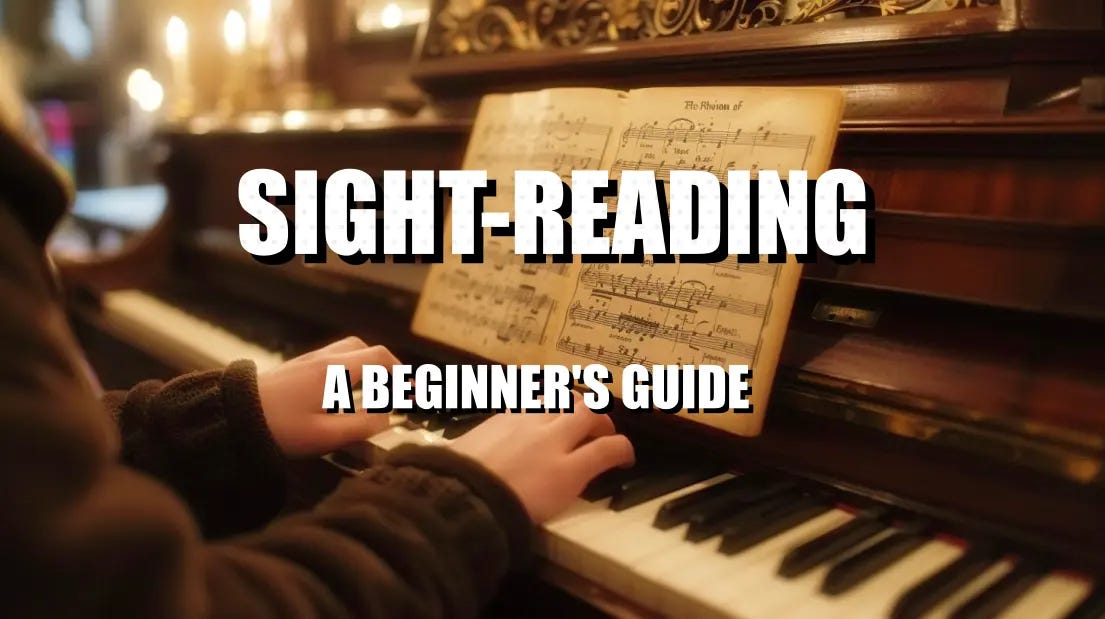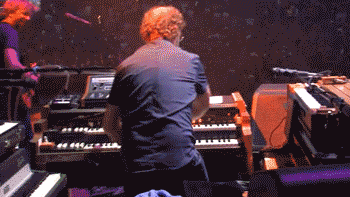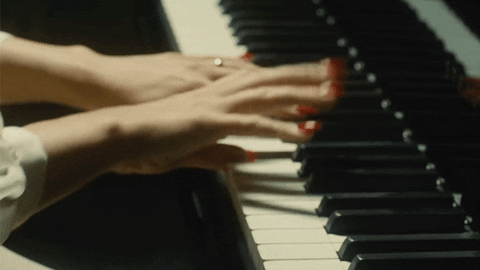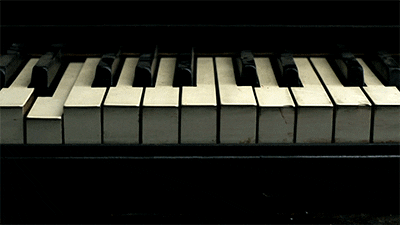Sight-Reading Made Simple: A Beginner's Guide
Feeling sight-reading fear? Our guide offers a friendly approach to building this skill, plus resources to help you excel.
Imagine sitting down at the piano, a brand new piece of sheet music staring back at you. Suddenly, your fingers feel like clumsy sausages, and your brain transforms into scrambled eggs. This is sight-reading, and while it can trigger a mild panic attack, it's actually a skill that opens up a world of musical possibilities.
Think of how experienced actors can read a script and nail the lines and emotions on the first try. Great musicians can do something similar with sheet music – minus the dramatic hand gestures (well, maybe not always). Sight-reading lets you dive into new pieces quickly, helps you learn music faster, and makes you a more versatile musician overall. Yes, it can be tricky, but with the right approach, anyone can improve. Let's break down what makes sight-reading so tough and how you can build your own mastery of this essential skill.
Why is Sight-Reading So Difficult?
Let's be honest, sight-reading a piece of music for the first time can feel like juggling chainsaws while reciting Shakespeare in Klingon. It's an impressive feat when it goes smoothly, and when it doesn't, well, let's just say it's not exactly a symphony of beautiful music. But why is this so darn hard?
The Multitasking Monster
Picture trying to read a story – except it's written in two different fonts, on two separate lines, and you have to read both lines out loud at the same time. Now, add complicated hand gestures that must change with every word. That's kind of what your brain handles with sight-reading! You're decoding notes in the treble and bass clef, interpreting rhythms, dynamics, and somehow coordinating both hands at the correct tempo. It's a mental workout!
Welcome to the Land of the Unknown
Each new piece is like stepping into an unexplored musical jungle. You're faced with unfamiliar chord shapes, weird squiggles that indicate intricate rhythms, and key signatures that might as well be written in hieroglyphics. Sure, after practice, things like major scales become second nature, but in the heat of sight-reading, there's always that moment of "What on Earth is that note?!"
The Dreaded "Play it Perfectly" Syndrome
There's an unspoken expectation to play a sight-read piece flawlessly, as if you've been practicing it for weeks. But sight-reading isn't about perfection, it's about deciphering the musical roadmap as you go. Even experienced musicians stumble! The pressure to nail every note creates unnecessary tension, making it even harder to focus and recover from those inevitable slip-ups.
So, Is It All Doom and Gloom?
Absolutely not! While sight-reading has its challenges, think of it like learning to ride a bike. There might be wobbles and a few scrapes along the way, but with consistent practice, you'll gain confidence, and eventually, it starts to flow. And, like any valuable skill, it takes effort, but the payoff for your musical journey is huge.
Let's move on to breaking down the building blocks of sight-reading. Once we understand these elements, that sheet music starts to look a lot less terrifying.
Building Blocks of Sight-Reading
Think of sight-reading like building a house. You wouldn't just start slapping walls together, would you? You need a strong foundation with solid building blocks. Here are the essentials to focus on when strengthening your sight-reading skills:
Rhythm Master
Rhythm is the heartbeat of music. If your timing is all over the place, even the simplest tune becomes a mangled mess. Start away from the piano with clapping and counting exercises. Once you've got a handle on the basics, practice integrating rhythm with scales and arpeggios on the piano. The goal is to make rhythm feel automatic, so your brain has room to tackle other things while sight-reading.
Intervals Are Your Friends
An interval is simply the distance between two notes. Recognizing intervals quickly, both by sight and sound, is a super power for sight-reading. Practice drills where you play and sing intervals. When you see those two notes on the page, you'll immediately know if it's a major third, a perfect fifth, or something else entirely.
Chord Ninja
Major and minor triads, dominant sevenths – these are your bread and butter chords. Learn to recognize them instantly by their shape on the staff. If you spot a familiar chord, it's like a flashlight guiding you through the musical terrain instead of fumbling note by note.
The Power of "Chunking"
Think about reading the word "the". Do you process each letter individually (t-h-e)? Of course not! You recognize it as a whole unit. Music is the same way. Train your eyes to identify patterns larger than single notes – scales, arpeggios, repeated melodic figures. Sight-reading becomes infinitely faster when you "chunk" groups of notes instead of reading one at a time.
Mental Prep
Before you start playing, give that sheet music a quick scan. Look for the key signature, tempo changes, anything that looks rhythmically tricky, and the overall "feel" of the piece. It's your 30-second strategy session before diving in.
Bonus Tip: Tools and Technology
Sight-reading apps and websites provide a wealth of practice materials at graded difficulty levels. Some even play the music while highlighting the notes in real-time, which helps to train your eyes and ears together.
Remember, building these foundational blocks takes time. Be patient with yourself, and soon you'll be surprised at how much more manageable that sheet music looks.
Sight-Reading Practice Strategies
Now that you've got a firm grip on the building blocks, it's time to implement them with clever practice techniques. The goal of sight-reading isn't immediate perfection; it's about getting more comfortable with the process of playing completely unfamiliar music.
Start Slow and Steady
Think of learning a new language. You wouldn't start by trying to give a public speech! Begin with short, simple pieces far below your usual playing level. The goal here is not to impress anyone but to get accustomed to decoding that musical language.
"Preview Mode" is Key
Before you touch a single key, do a quick analysis of the piece. Check the key signature, tempo, unusual rhythmic figures, and the overall structure (does it repeat sections, etc.). This little bit of prep eliminates surprises and lets you make a more confident start.
Keep the Train Moving
It's natural to freeze up when you hit a snag. Resist the urge to rewind and fix every mistake! Focus on maintaining the rhythm and tempo, even if means simplifying what you're playing for a few bars to keep going. The point is to avoid getting entirely derailed and to train your ability to recover on the fly.
Graded Difficulty
There's a massive selection of sight-reading workbooks and apps out there. These allow you to start with ridiculously easy material and gradually work your way up. Progressing slowly with small wins provides much-needed encouragement!
Make It Fun
Sight-reading doesn't always have to be a serious, solitary drill. Find a fellow musician friend and do sight-reading duets together. Or, here's a goofy one: take pieces far below your skill level and try sight-reading them at a ridiculously fast tempo just for laughs. Taking the pressure off sometimes unlocks surprising progress.
More Advanced Techniques
Once you get comfortable with the basics, try these variations to level-up:
Transpose on the fly: Sight-read in a different key than written. This trains your brain to recognize patterns, not just individual notes.
"Hand swap": Sight-read simple pieces, but switch your hands so you're playing the melody in the bass clef and the accompaniment in the treble. This may make your brain hurt at first but will boost your musical flexibility.
Listen Up
If you can, find a recording of the piece you're about to sight-read and give it a listen a few times. This helps build a "soundtrack" inside your head, which makes your hands less likely to go rogue when playing it yourself.
The Bottom Line
Sight-reading, like any skill, improves over time with regular practice. Dedicate even just 15-20 minutes a few times a week. You'll be amazed at the leaps you'll make. Soon, that intimidating sheet music will start to look more like an exciting adventure and less like an impossible Sudoku puzzle.
Additional Tips
Think of these as extra tools to add to your sight-reading toolkit. Experiment and see what works for you!
Sight-Sing It Out: Before you play a piece, try singing or humming through the melody. This forces you to focus on the pitches and rhythms without worrying about what your fingers are doing.
Record Yourself: Play a piece you've sight-read, record it, then take a listen. It's much easier to spot areas needing improvement from a listener's perspective.
Embrace the Mistakes: Nobody is perfect, especially when sight-reading! View errors as stepping stones – they show you exactly where to focus your practice for tomorrow.
Find Your Sight-Reading Tribe: Consider joining a sight-reading group or finding a music buddy online for mutual accountability and support.
Most Importantly, Have Fun: Sight-reading should be a rewarding challenge, not a source of stress. If you're truly not enjoying it, take a break! Coming back with a fresh perspective often works wonders.
The Takeaway
Sight-reading is a journey, not a destination. Consistent effort, even in small increments, truly adds up over time. Soon, you'll gain the confidence to tackle any piece of sheet music that comes your way, opening up a whole new world of musical possibilities.
Ending words
Sight-reading is one of the most empowering skills a pianist can possess. It gives you access to a vast library of music, accelerates your learning process, and ultimately makes you a more well-rounded and flexible musician. While it may seem daunting at first, with the strategies we've covered, tackling that unfamiliar sheet music becomes an exciting endeavor.
Remember, progress isn't always linear. Some days will feel smoother than others. Embrace the journey, celebrate the small victories, and don't be afraid to laugh at the occasional musical train wreck along the way! With dedication and a positive attitude, you'll transform sight-reading from a source of anxiety into an exhilarating musical adventure.









